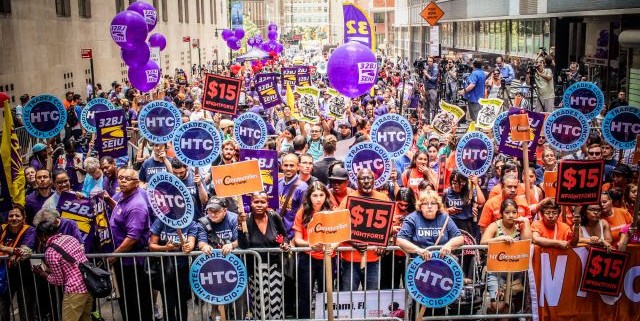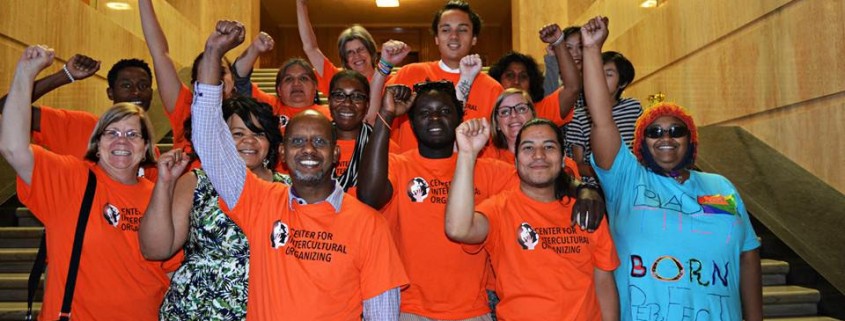Thirty organizers and activists from across Indian Country came together in Seattle in June for a special training opportunity hosted by the Native Organizers Alliance: the annual intensive four-day Native Organizing Training.
Grassroots organizing is both an art and a science. In Indian Country, the art of organizing is reflected in the Native-led action against oil drilling in the Arctic by the ‘Kayaktivists’ in the “Paddle in Seattle”, and the round dance flash mobs of Idle No More.
In four days our aim was to study the science of organizing – Native style, in keeping with our traditions and with our history.
In our jam-packed, daylong sessions, we explored ways to build Native organizers’ skills to meet the unique challenges of organizing in Native communities, on reservations, and in urban and rural centers. We shared lessons, best practices and examined the techniques for building a stronger grassroots movement for social change in Indian Country.
In the end some participants said we needed another day, and most agreed we needed more breaks and time to digest the information. Good advice for next year’s Native Organizing Training!
While exploring the nuts and bolts of outreach, leadership development, strategy and tactics, the participants worked to find the unique, yet critical elements of community engagement that flow from Indian Country’s history and traditions.
After four intensive days together, it is clear that here is so much more to learn about how to deepen our understanding of Native community organizing.
This is just the beginning! The future of Indian Country rests on growing a broad infrastructure of Native organizers and activists who facilitate campaigns that get at the root causes of the lack of jobs, healthy communities and protect treaty rights, sovereignty and Mother Earth from destruction.
The training provided an opportunity to share stories of the tremendous challenges our communities face and our vision and passion for bringing about structural change that will help Native communities not only survive, but also thrive.
The participants were hungry for more opportunity to go deeper into the challenges they face on the ground. Next year’s sessions will need to provide that opportunity in various ways.
Some participants asked that we now consider regional trainings that go beyond Native Organizing 101, to tackle more real life, complicated strategic challenges in Indian Country.
Some suggested segments focused on political empowerment related to advocacy, voter engagement and lobbying. In their written evaluations most said that the most important part of the experience was getting together with others who share a common outlook on movement building in Indian Country.
Especially impressive were the younger participants,coming from cutting edge Indian Country experiences. For instance, one of the activists is a part of the occupation to protect sacred Apache land from uranium mining in Oak Flat, AZ. Another was a Native radio talk show host, and one young man will be headed to the White House for the Native youth gathering in the next week.
One woman representing the “AIM generation” (radicalized in the 1970s) is a traditional Dine organizer. She has been fighting for decades for compensation from the coal and uranium mining companies for the contamination of Navajo land, water and air. She felt uplifted by the energy of the young organizers in the room, who are just beginning the fight for justice in their communities.
One of the most popular sessions of the training was on power mapping. David Bender, the community organizer for the American Indian Center of Chicago, said learning how to map the potential allies and likely opponents in an organizing campaign will help him prepare both his leaders and grassroots members to think and engage more strategically in their work.
At the end of fast-paced week, participants – whether they work in small villages in Alaska, on the Navajo or Hopi Reservations, or in the heart of Chicago, Portland or Billings – went home inspired by the knowledge that they are a part of something bigger. Our hope is that the participants will continue to work together with support from the Native Organizers Alliance to amplify a stronger Native voice on key issues at the national level.
One young participant said, “Nothing is more important for organizers than having a collective with so many common experiences. I see myself working closely with my fellow students and the trainers as we go forward.”
The sheer demand for this training says something powerful about the groundswell of the grassroots upsurge in Indian Country: in a few short weeks, more than 130 people submitted applications for the 30 available slots.
Now the work will continue at home and at the Native Organizers Alliance. Some of the participants will help organize local Native trainings in Alaska, Montana, and South Dakota. One participant even volunteered to become a Native Organizers Alliance trainer.
On the national level, we are organizing a national advisory board and growing a circle of partner organizations that we will provide with trainings, and technical support such as research and joint fundraising to keep grassroots organizing moving in Indian Country.
Personally, it was inspiring to hear the journeys so many have taken to carry on and preserve – despite many difficulties – our history, cultures, and future. It is extremely important in our communities to widen the circle of those who can take action that will in many ways help our people to heal with pride and commitment to our common struggle.
I was also struck by the heightened awareness of the need for unity in Indian Country. There is so much more that unites us than divides us. The unity that exists between those who organize on the Rez, in rural areas or urban centers, and those who continue the struggle for tribal recognition, serves as the key to building alliances with the vast cross section of people in the U.S. – those who can and must be a part of the movement for justice in Indian Country.
The curriculum, preparation, and training, was a collaborative effort and would not have been possible without Ozawa Bineshi Albert (former organizer for the Center for Community Change and Native American Voters Alliance in New Mexico) and Donavon Hawk (activist and leader from Montana), my co-facilitators.
With much love and respect to all who participated in the 2015 Native Organizing Training. A new circle of movement building in Indian Country has begun, thank you!
For more information on the Native Organizers Alliance: http://www.nativeorganizing.org/

